The Human Eye and The Colorful world Class 10th Notes- Free NCERT Class 10 Science Chapter 11 Notes - Download PDF
Have you ever thought about the way that a rainbow is formed after a rain, or have you ever wondered why the stars shine so bright in the night? The solution is in the NCERT Class 10 Science Chapter 10 Notes - Human Eye and Colourful World. The chapter describes some interesting things about nature, like the scattering of light, the formation of rainbows, the distribution of sunlight, the blue colour of the sky and the red sunsets and the structure and workings of the human eye.
This Story also Contains
- Human Eye and Colourful World Class 10 Notes: Download PDF
- NCERT Class 10 Science Chapter 10 Notes Human Eye and Colourful World
- How to Master Class 10 Science Chapter 10 Human Eye and the Colourful World?
- Importance of Class 10 Physics Chapter 10 Notes
- Class 10 Chapter Wise Notes Science
- NCERT Books and Syllabus
One of the most critical and scoring chapters in CBSE Class 10 Board Exams and competitive exams such as NSO, NTSE and NSEJS is Chapter 10. The Class 10 Science Chapter 10 Human Eye and Colourful World Notes are created by expert teachers according to the latest CBSE syllabus. These NCERT notes Class 10 Science Chapter 10 Human Eye and Colourful World have straightforward, but detailed descriptions of important concepts including the mechanism of the human eye, power of accommodation and eye defects (myopia, hypermetropia, presbyopia) and how it is corrected with a lens or a prism, the scattering of white light and scattering of light which explains real world phenomena like twinkling of stars and colour of the sky. These NCERT notes Class 10 Science Chapter 10 Human Eye and Colourful World are written in simple language that students can understand, and they are also easy to revise and provide a clear understanding of concepts and get ready to take exams. These NCERT notes can be used as a full revision manual to enhance your ideas and improve your grades.
Also Read
Human Eye and Colourful World Class 10 Notes: Download PDF
Class 10 Science Chapter 10 Human Eye and Colourful World Notes PDF are very clear and concise in giving an account of all the key issues, including the structure of the human eye, defects in vision, refraction of a prism, dispersion of light, scattering and natural phenomena like rainbows and twinkling of stars. Ready according to the most recent CBSE syllabus, this PDF is ideal to have quick revision and board exam preparation.
NCERT Class 10 Science Chapter 10 Notes Human Eye and Colourful World
The Chapter 10 Notes of NCERT Class 10 Science Chapter 10 Human Eye and Colourful World explains the working of the human eye and the reasons why we can see different natural optical phenomena in our surroundings. These Human Eye and Colourful World Class 10 Science Chapter 10 CBSE notes make important things easier, such as eye accommodation, eye defects, light dispersion, and rainbows creation. They are made to be easy and fast to revise, thus enabling the students to study well and achieve good grades. They can be used particularly in preparing for board and competitive examinations.
The Human Eye
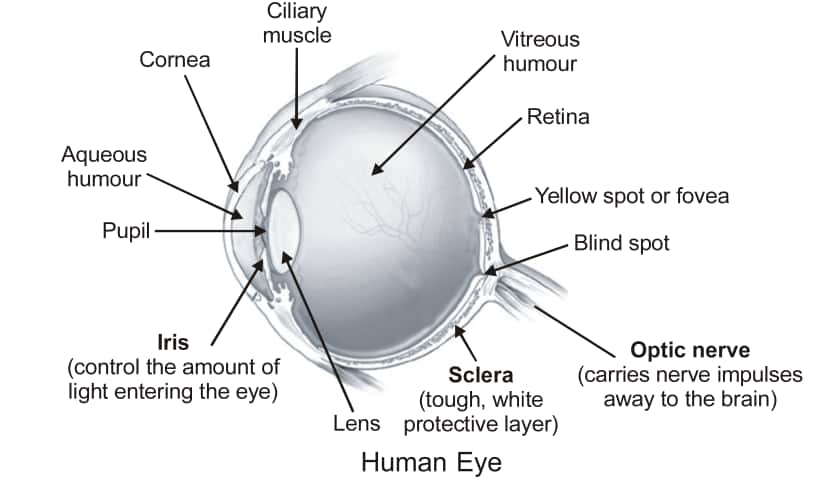
- It is one of the most sensitive sense organs that is present in living organisms
- The image is formed on a screen that is light-sensitive, known as the Retina.
- A thin membrane in the eye through which light enters the eye is known as the Cornea.
- Eyeballs are spherical.
- The presence of the lens helps in adjusting objects at different distances on the retina.
- The dark, muscular structure which controls the size of the pupil is the Iris. Hence, the pupil regulates the amount of light entering the eye.
- Real, inverted images are formed on the retina. It contains light-sensitive cells, Rods and Cones. These cells send signals to the brain with the help of the optic nerve
Power of Accommodation
The focal length of the lens in the eye can be decreased or increased. The eye lens gets thin when muscles are relaxed. This results in increased focal length. It helps to see distant objects. And when the eye lens becomes thick, the focal length is decreased, and we see nearby objects.
The power of accommodation is the ability of the eye lens to adjust the focal length.
-
The near Point of the Eye is at 25 cm, and the Far Point of the Eye is infinity.
-
In old age, the lens becomes milky and cloudy, which is called a Cataract. This leads to complete or partial loss of vision.
Defects of Vision and Their Correction
The three common defects of vision are:
Myopia (Nearsightedness): In this, distant objects cannot be seen clearly, but nearby objects are visible.
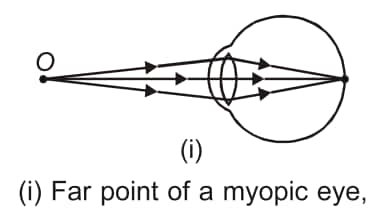
Light from a far object forms an image before it reaches the retina.
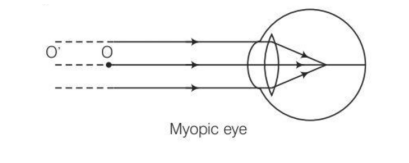
Corrected using a concave lens.

Hypermetropia (Far-sightedness): Nearby objects are seen clearly, whereas distant objects can not be seen clearly.
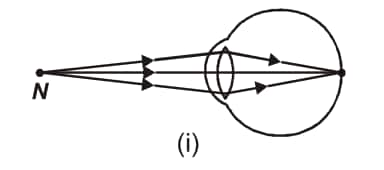
An image of a nearby object is formed behind the retina.
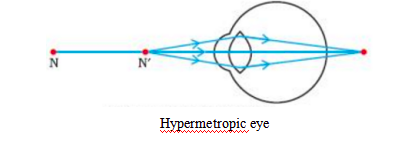
Corrected using a convex lens.
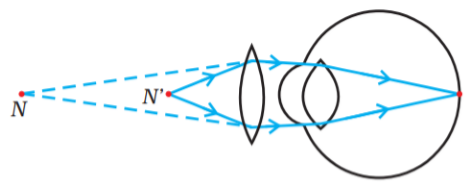
Presbyopia: The power of accommodation decreases with ageing. They have difficulty with near vision as well as far vision. Bifocal lenses are used to correct the defects.
Refraction of Light Through a Prism
A glass prism is a refracting medium with two or more non-parallel refracting surfaces. It is named according to the shape of its base. The prism shown below is a triangular prism which has two triangular bases and three rectangular lateral surfaces. For a triangular glass prism, the angle between the non-parallel (lateral) refracting surfaces is known as the angle of the prism, denoted by
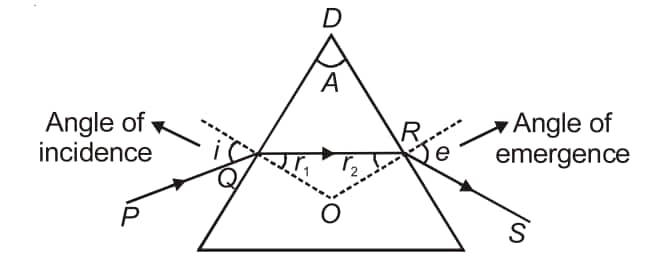
When light passes through a prism as shown in the figure below, it gets deviated, and the angle between the emergent ray and the incident ray is called the angle of deviation (
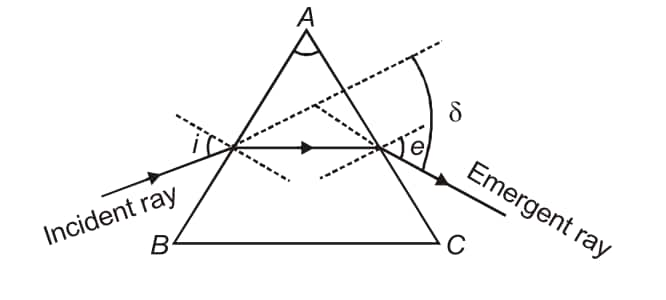
Dispersion of White Light By A Prism
When light falls on the prism, the prism splits the incident light into a band of seven colours. The colours observed are VIBGYOR (Violet, Indigo, Blue, Green, Yellow, Orange and Red). The band of colour is Spectrum. Thus, the splitting of incident light into different colours is Dispersion. The splitting is because of the bending of light rays at different angles. Violet light bends the most, whereas red light bends the least.
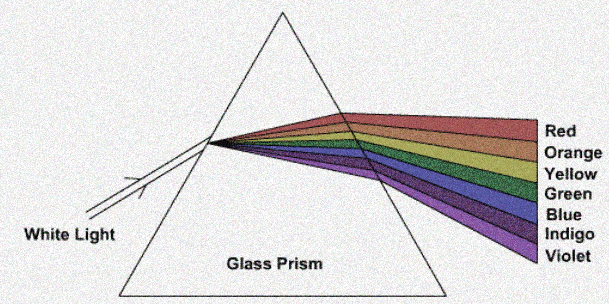
Recombination of the spectrum of white light-
1 more prism is placed in an inverted position to get back the white light
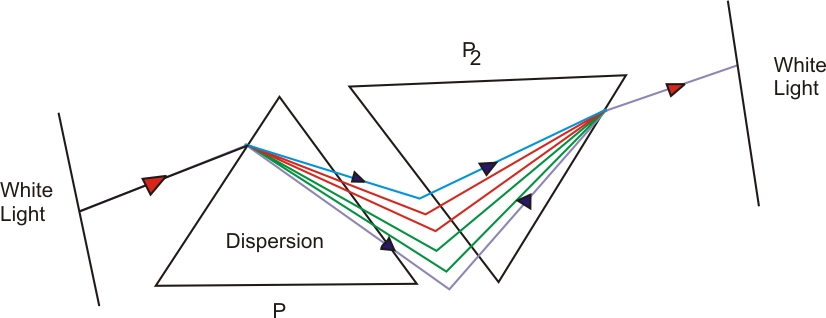
The phenomenon of a rainbow is also due to the dispersion of light.
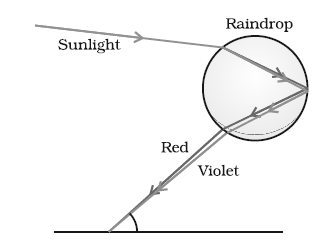
Atmospheric Refraction
With height, the layers of the atmosphere change, so does its optical density; hence, light entering the Earth's atmosphere undergoes refraction continuously. The refraction of light by the Earth's atmosphere is termed atmospheric refraction. Now, let us see a few phenomena occurring in nature due to the atmospheric refraction of light.
Twinkling of Stars
When a star is lit in the atmosphere, it has to undergo refraction. The refractive index changes, and the light bends towards the normal. As a result, the actual position of the star is a little bit different from its apparent position. We also know that the atmosphere of the Earth is not stationary, so changes in the apparent position of the stars occur. Thus, we see them twinkling in the sky or the Earth’s atmosphere.
Advance Sunlight and Delayed Sunset
Due to the phenomenon of atmospheric refraction, the sun is visible 2 minutes before the actual sunrise, which is known as advanced sunlight. Just like the sunrise, the Sun is also visible 2 minutes after the actual sunset has taken place. This is known as Delayed Sunset.
Scattering of Light
When sunlight falls on a mixture of minute particles (like smoke, tiny water droplets, suspended particles of dust and molecules of air in the earth's atmosphere), it gets scattered in all directions if the size of the particle is comparable to the wavelength of light. These particles are more effective in scattering light of shorter wavelength at the blue end than light of longer wavelength at the red end.
Tyndall Effect
When a beam of light strikes tiny water droplets and suspended particles of dust, the path of the beam becomes visible. This is the Tyndall Effect. Fine particles scatter, and particles of larger size scatter light of longer wavelengths.
Why does the sky appear blue?
The colour of the sky appears blue because of the scattering of light. When the sunlight passes through the atmosphere, the fine particles present in the air will scatter the blue colour since it has a shorter wavelength.
Why does the sky appear red during sunrise and sunset?

When the Sun rises and sets, its light, which is present near the horizon, passes through thicker layers of atmosphere and travels larger distances before reaching our eyes. When the light of the Sun present overhead travels a comparatively shorter distance than light from the horizon, it results in the white appearance of the sun. Near the horizon, most of the blue light and shorter wavelengths are scattered by the particles. Therefore, the red light that reaches our eyes has the longest wavelength, hence the sky appears reddish.
How to Master Class 10 Science Chapter 10 Human Eye and the Colourful World?
To master Class 10 Science Chapter 10, one needs to have a good grasp of the functioning of the human eye and optical phenomena that colour the world we live in. This chapter relates actual life observations, such as rainbows, blue skies, and twinkling stars, with scientific concepts. Through a proper study plan, concentrated concept building and practice, students can achieve full marks in this high-weightage chapter.
- Begin by studying how the human eye is made with labelled diagrams to gain knowledge about the functions of the retina, pupil, iris, lens, and optic nerve.
- Learn about the power of accommodation using examples such as reading a book and looking at objects that are far.
- Learn the most common eye defects: myopia, hypermetropia, and presbyopia, and how each of them is addressed with the help of certain lenses.
- Ray diagrams of defects of the eye and their correction; these are common in CBSE board exams.
- Learn about the refraction of light using a prism and update the understanding of refraction using a triangular prism made of glass.
- Study the dispersion of white light and how a spectrum of VIBGYOR is developed.
- Repeat the experiment of Newton and learn why light separates into various colours.
- Understand the phenomena of atmospheric refraction that can explain events such as the twinkling of stars and the delayed sunset.
- Experiment with light scattering to get to know why the sky is blue and why it turns reddish in a sunrise and sunset.
- Solve all NCERT In-text and Exercise questions, as they frequently appear in board exams.
Importance of Class 10 Physics Chapter 10 Notes
Human Eye and Colourful World Class 10 Science Chapter 10 CBSE notes are necessary to learn the operation of the eye and the reason why we see such beautiful phenomena as a rainbow, blue sky, and twinkling stars. The complex concepts like dispersion, scattering of light and eye defects become easy to learn as well as to revise in these Human Eye and Colourful World Class 10 Science notes. They enable students to develop excellent conceptual clarity and are very helpful in the CBSE board exam and other competitive exams.
Covered Key CBSE Syllabus
- These Class 10 physics chapter 10 notes contain all the important concepts like the structure of the human eye, power of accommodation, defects of the eye, refraction of light using a prism, dispersion of light, scattering of light and natural phenomena like display of a rainbow and twinkling stars.
Short Revision Resource
- Students are able to revise the complete chapter within a limited duration using such Class 10 physics chapter 10 notes just prior to the CBSE Class 10 board exams.
Enhances Exam Preparation
- Notable formulas, definitions and diagrams are highlighted with a simple, easy-to-understand format to enable students to gain better marks.
Helpful in Competitive Examinations
- The Human Eye and Colourful World Class 10 Notes will also be helpful in competitive examinations such as NSO, NTSE, and NSEJS, where clarity of concept of light, refraction and scattering is very important.
Easy to Understand Explanations
- Vast, technical concepts such as prism refraction, atmospheric refraction, and light scattering are explained by using simple life examples (blue sky, red sunsets, and how a rainbow is formed).
Saves Time and Improves Retention
- Properly organised NCERT Class 10 notes PDF will help students to revise in a shorter time and memorise important elements.
Free Downloadable Resource
- Human Eye Chapter 10 Notes PDF are easy to obtain and download by students who may study offline at any time.
Class 10 Chapter Wise Notes Science
Get line-by-line and well-organised notes of all chapters of Physics, Chemistry and Biology according to the new NCERT Class 10 Physics, Chemistry and Biology textbook. The following notes will give major ideas, formulae, illustrations and other important explanations to enable the students to revise quickly and prepare to take the CBSE board exams.
NCERT Solutions of Class 10 Subject Wise
NCERT Class 10 Exemplar Solutions for Other Subjects
NCERT Books and Syllabus
Frequently Asked Questions (FAQs)
It is the capability of the eye lens to change the focal length in such a way that it can be in a position to focus the keen eye on nearby and distant objects clearly on the retina.
Simple convex and concave lenses are not useful in the correction of astigmatism; cylindrical lenses are needed.
The formation of a rainbow is a result of a combination of refraction, dispersion and total internal reflection of sunlight on the droplets in water.
Scattering of light by various particles in the atmosphere causes shorter wavelengths (blue) to scatter as compared to longer wavelengths (red).
Always:
Compare the retina and the eye lens.
Show the image whether it is in front of or behind the retina.
Indicate with arrows the correction with the appropriate lens.
Courses After 12th
Applications for Admissions are open.
As per latest syllabus. Physics formulas, equations, & laws of class 11 & 12th chapters
JEE Main Important Chemistry formulas
Get nowAs per latest syllabus. Chemistry formulas, equations, & laws of class 11 & 12th chapters
JEE Main high scoring chapters and topics
Get nowAs per latest 2024 syllabus. Study 40% syllabus and score upto 100% marks in JEE
JEE Main Important Mathematics Formulas
Get nowAs per latest syllabus. Maths formulas, equations, & theorems of class 11 & 12th chapters
